
Sphalerite is a sulfide mineral with the chemical formula (Zn,Fe)S. It is the most important ore of zinc. Sphalerite is found in a variety of deposit types, but it is primarily in sedimentary exhalative, Mississippi-Valley type, and volcanogenic massive sulfide deposits. It is found in association with galena, chalcopyrite, pyrite, calcite, dolomite, quartz, rhodochrosite, and fluorite.
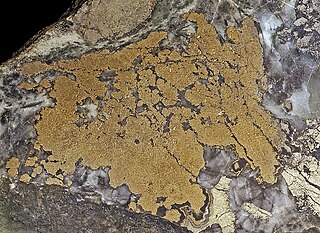
Nickeline or niccolite is a mineral consisting primarily of nickel arsenide (NiAs). The naturally-occurring mineral contains roughly 43.9% nickel and 56.1% arsenic by mass, but composition of the mineral may vary slightly.
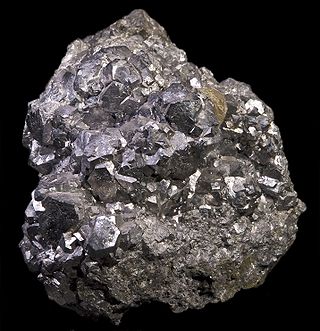
Skutterudite is a cobalt arsenide mineral containing variable amounts of nickel and iron substituting for cobalt with the ideal formula CoAs3. Some references give the arsenic a variable formula subscript of 2–3. High nickel varieties are referred to as nickel-skutterudite, previously chloanthite. It is a hydrothermal ore mineral found in moderate to high temperature veins with other Ni-Co minerals. Associated minerals are arsenopyrite, native silver, erythrite, annabergite, nickeline, cobaltite, silver sulfosalts, native bismuth, calcite, siderite, barite and quartz. It is mined as an ore of cobalt and nickel with a by-product of arsenic.

Jamesonite is a sulfosalt mineral, a lead, iron, antimony sulfide with formula Pb4FeSb6S14. With the addition of manganese it forms a series with benavidesite. It is a dark grey metallic mineral which forms acicular prismatic monoclinic crystals. It is soft with a Mohs hardness of 2.5 and has a specific gravity of 5.5 – 5.6. It is one of the few sulfide minerals to form fibrous or needle like crystals. It can also form large prismatic crystals similar to stibnite with which it can be associated. It is usually found in low to moderate temperature hydrothermal deposits.

Enargite is a copper arsenic sulfosalt mineral with formula Cu3AsS4. It takes its name from the Greek word enarge, "distinct". Enargite is a steel gray, blackish gray, to violet black mineral with metallic luster. It forms slender orthorhombic prisms as well as massive aggregates. It has a hardness of 3 and a specific gravity of 4.45.

Sulfosalt minerals are sulfide minerals with the general formula AmBnXp, where

Freieslebenite is a sulfosalt mineral composed of antimony, lead, and silver. Sulfosalt minerals are complex sulfide minerals with the formula: AmBnSp. The formula of freieslebenite is AgPbSbS3.

Livingstonite is a mercury antimony sulfosalt mineral. It occurs in low-temperature hydrothermal veins associated with cinnabar, stibnite, sulfur and gypsum.

Aguilarite is an uncommon sulfosalt mineral with formula Ag4SeS. It was described in 1891 and named for discoverer Ponciano Aguilar.
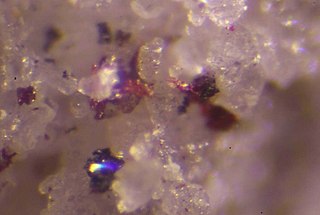
Routhierite is a rare thallium sulfosalt mineral with formula Tl(Cu,Ag)(Hg,Zn)2(As,Sb)2S6.

Baumhauerite (Pb3As4S9) is a rare lead sulfosalt mineral. It crystallizes in the triclinic system, is gray-black to blue-gray and its lustre is metallic to dull. Baumhauerite has a hardness of 3.

Aktashite is a rare arsenic sulfosalt mineral with formula Cu6Hg3As4S12. It is a copper mercury-bearing sulfosalt and is the only sulfosalt mineral with essential Cu and Hg yet known. It is of hydrothermal origin. It was published without approval of the IMA-CNMNC, but recognized as valid species by the IMA-CNMNC Sulfosalts Subcommittee (2008).

Coloradoite, also known as mercury telluride (HgTe), is a rare telluride ore associated with metallic deposit. Gold usually occurs within tellurides, such as coloradoite, as a high-finess native metal.
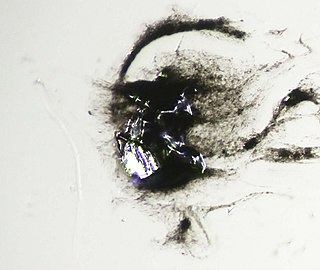
Gabrielite is an extremely rare thallium sulfosalt mineral with a chemical formula of Tl6Ag3Cu6(As,Sb)9S21 or Tl2AgCu2As3S7.
Guettardite is a rare arsenic-antimony lead sulfosalt mineral with the chemical formula Pb(Sb,As)2S4. It forms gray black metallic prismatic to acicular crystals with monoclinic symmetry. It is a dimorph of the triclinic twinnite.

Ardaite is a very rare sulfosalt mineral with chemical formula Pb19Sb13S35Cl7 in the monoclinic crystal system, named after the Arda River, which passes through the type locality. It was discovered in 1978 and approved by the International Mineralogical Association in 1980. It was the second well-defined natural chlorosulfosalt, after dadsonite.

Daubréelite is a rare sulfide mineral. It crystallizes with cubic symmetry and has chemical composition of Fe2+Cr3+2S4. It usually occurs as black platy aggregates.

Playfairite is a rare sulfosalt mineral with chemical formula Pb16Sb18S43 in the monoclinic crystal system, named after the Scottish scientist and mathematician John Playfair. It was discovered in 1966 by the Canadian mineralogist John Leslie Jambor. Lead gray to black in color, its luster is metallic. Playfairite shows strong reflection pleochroism from white to brownish gray. Playfairite has a hardness of 3.5 to 4 on Mohs scale and a specific gravity of approximately 5.72.
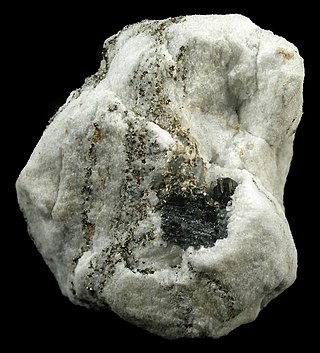
Sartorite is a lead arsenic sulfide with the chemical formula PbAs2S4 and as type locality the Lengenbach Quarry in Legenbach, Binnental, Valais, Switzerland. Historically, sartorite has been thought isomorphic to chalcostibite, emplectite, and zinckenite, but was definitively distinguished from the others in 1939.

John Leslie Jambor was a Canadian geologist and mineralogist. Jambor was an exceptional figure in the field of mineralogy and a major contributor to the Mineralogical Association of Canada (MAC).
Jambor has a Scopus h-index of 38.



















